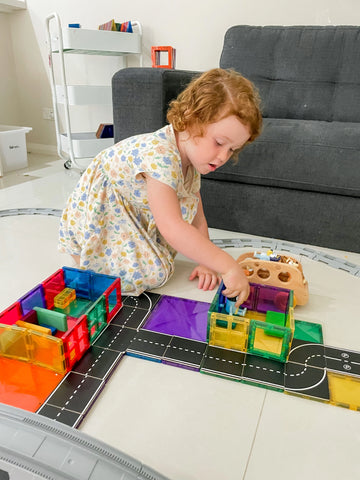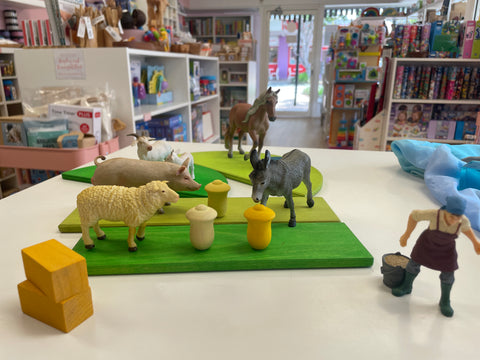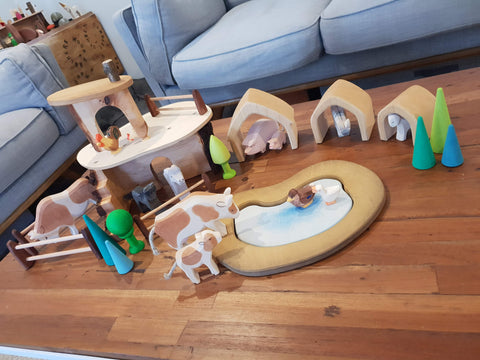
So what is small world play?
Small world play is simply imaginative play but with items small than they are in real life.
It is a lot of fun and it's a great way to help develop and nurture a child's imagination. Children usually start to begin playing imaginatively between ages 2-3 years and over the next few years you'll see their imagination continue to grow.
Children can use figurines, loose parts and items in miniature sizes to create their own stories and play imaginatively creating places, settings, problems or scenarios that they can connect and engage with to tell a story.

Why is it beneficial?
Small world play helps children to be creative and imaginative and is a place where they can make sense of their world whilst also building their social skills, language and understanding the world around them.
Through play it provides opportunities for children to recreate scenarios that they may have seen in person, watched on a show or read about in stories.
Small world play can also help children develop problem solving skills. For example during play you could discuss how many ducks fit in the pond or what the animals could eat?
They will work through these problems and solve them by using their imagination, reasoning and experimenting. You can also build on their numeracy and literacy skills by talking about how many people live in a house or how many different types of animals are in the zoo.

Role playing sceanarios
Parents and carers can also use small world play to prepare children for new situations a child may face such as going to school or to the doctors by creating a scenario for them to play in beforehand.
During play adults can act out a scenario or routine for example hopping in the car, driving to school, saying goodbye and returning later in the day - Be sure to also get children involved in the story and play as well!
In doing this we can help children become exposed to different places without having been there before which may help to reduce anxiety ahead of going to unfamiliar places.

Setting up a Small World
If this is one of the first times you're setting up a small world try making it familiar to somewhere they have been or familiar with such as the zoo or a cafe. Here Big Sis recreated a zoo after a visit. And below that we made a car wash after going through one!



Incorperating characters from favourite TV shows or stories can be really helpful too for getting children interested in small world play. We love retelling and creating scenes from epidodes of Bluey in our house!


Simple invitations to play
When I create an invitation to play that is focused on small world play I like to start by making a few enclosures such as a house or fence around a few animals.

I then leave more resources that they could use nearby so my children can decide the story they want to create and tell.

Through my experience I have found this engages them more than coming into a completed scene. It also lengthens their time at the activity as they need to create the story and then play with it, telling the story.
Whilst creating they like to tell stories about who lives where or who is in a family. I like to sit close by and engage with them verbally and also help them build what they are imagining. I don’t physically build unless they ask me to create something for them. They usually only ask for a couple of things such as the school or ask how to create something a few times then they use my inspiration to build something similar next time.

I create whatever they have asked for but involve them by asking questions like:
“What would you like to be in the school?”
“How do you think I could make a mat?”
I like to involve them in the build by asking if they could bring me more magnetic tiles to complete the playground and so on.
Once I have completed what they asked for I then sit back and wait until I am given more direction. I also often leave them to play independently and come back and forth between their play and housework.
Our favourite items for Small World Play
We like to keep our small world play items mostly the same as what we use during regular play with our favourite open ended toys.


I’ve listed them below along with some examples of what my children like to use them for in small world play.
Playsilks - They like to lay them on the ground as water, sand, mud, grass and also to cover a house.
Connetix Tiles - To create structures such as houses or garages, roads, footpaths, fences, cars.
Mandala Pieces and Crystals - They love to use loose parts as trees, flowers, food for animals, rubbish in a truck etc.
Peg People and Figurines - We enjoy peg people as they have no facial expressions or gender they can be whoever they please such as grandma, mum, teacher etc.
The Tenderleaf Dolls are painted to represent people with some children gravitate more towards.
We also enjoy the range of Maileg mice.
Waytoplay Roads and/or Train Tracks - They love to build the roads and train tracks around the towns that they create.
The Tile Toppers are a perfect addition to magnetic tiles to make roads and train tracks too.
Animals - We have a range of both Ostheimer and also the CollectA animals.
Cars & Trucks - Our favourites would be the Grimm’s convertibles, trucks and also the construction vehicles.
Fences or Blocks - Used to enclose animals when creating a zoo or farm and also to create structures such as houses.
Tree House - The small treehouse is a favourite of ours as I like how the pieces can be pulled apart to create multiple houses or a barn.


Written by Alison Barnhill



